Remote thermostat for heating boiler. Programmable thermostat for heating system. Mechanical thermostat for heating boiler
A solid fuel heating boiler is an option for those who want to have an autonomous, inexpensive heating system that does not depend on gas supply and electricity in their home. The main thing is to stock up on firewood, coal, wood pellets, sawdust and other solid combustion products, on which the boiler will work. And through the process long burning solid fuel the temperature in the house will always be the right one, and in order to control and regulate the temperature in the house, of course, you will need a thermostat.
Types of boilers and the need for thermostats
In this form heating system often used cast iron and steel boilers. Both have both positive and negative characteristics. For example, steel have high heat transfer, fast heating and a relatively low price. But they can be exposed to the external environment. Then, with corrosion or clogging, the entire thermal system can deteriorate. To avoid this, it is necessary control the temperature in the boiler and regulate the temperature regimes.
Cast iron, on the contrary, have high strength, practically resistant to corrosion and environmental influences, reliable and stable in operation, keep heat for a long time, consist of easily replaceable sections. But long-burning solid fuel boilers, according to experts, can only fail in the event of sudden changes in temperature. Therefore, when installing such a boiler, it is necessary to properly and professionally piping the boiler. And, of course, you need to constantly monitor the temperature regime and adjust it as needed.
According to experts, when using a thermostat, 15-20% of fuel is saved, heat is stored in the required parameters, and, if necessary, the entire heating system is turned on or off.
What is the difference between a thermostat and a thermostat
 The thermostat is already included in the heating system and is responsible for the operation of the coolant. This is a mechanical device, which, as a rule, Its plus is that you can constantly monitor the temperature in the coolant, this process does not depend on the availability of electricity in the house. Minus - you will regulate the temperature manually.
The thermostat is already included in the heating system and is responsible for the operation of the coolant. This is a mechanical device, which, as a rule, Its plus is that you can constantly monitor the temperature in the coolant, this process does not depend on the availability of electricity in the house. Minus - you will regulate the temperature manually.
Temperature controller - separately mounted mechanism, which automatically monitors the temperature of the coolant, the room, controls it, regulates the correct required heat supply. And does it all during the day automatically, without user intervention.
Nuances of use
Thermostats for solid fuel boilers must be set to average temperature at home +20 degrees Celsius. But there are nuances:
- In the children's room, the temperature is preferably +22.
- In a room where elderly people live, people with disabilities +23.
- In the case of residence of hypertensive patients, it is better to keep a lower temperature regime of +18, +19.
- At night it is recommended +19, +21.
Types of thermostats
The choice of temperature controllers is huge - from mechanical thermostats to programmable, microprocessor-based.
- So called room regulators are installed in any room and react to the temperature in it. The main thing during installation is not to cover the devices with furniture, curtains, any objects. Then the indicators may not coincide with reality, and the whole system will fail.
- The valve regulator is tied to a specific fuel line and controls the temperature regime not of the boiler itself, but of the segment in a certain place where the valve is installed, mounted in the pipe.
- The automatic cylinder thermostat is the simplest device for a two-chamber conventional boiler. This device is installed on the boiler, is programmed, as a rule, only for the maximum temperature and causes the boiler to turn off when the temperature of the heating element exceeds the programmed one.
- Zone regulators - are programmed for a specific zone of the room and prevent not only shutdown or high temperature, but also report all the indicators that the consumer needs to know.
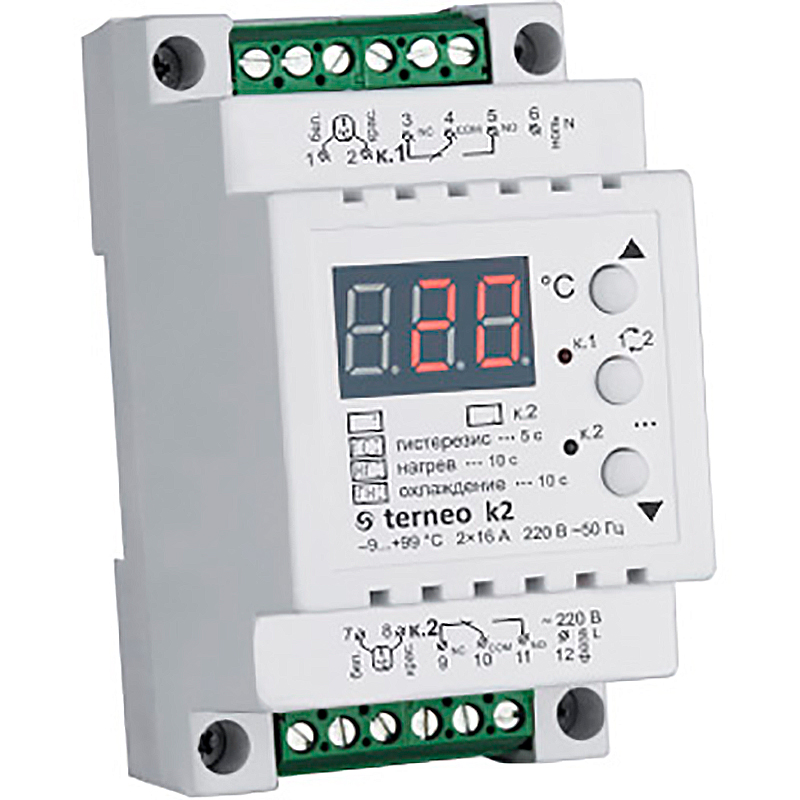
In addition, all thermostats are divided into:
- Wired.
- Remote.
The main selection criterion is ease of installation. It must also be taken into account that boiler and thermostat were compatible. To do this, you need to buy all the equipment from one manufacturer or seek the help of specialists.
Many owners of private houses arrange in their homes autonomous system heating, which ensures the effective creation of a comfortable atmosphere in the rooms of the dwelling. Any such system has the ability to adjust the temperature level. This is ensured by the thermostat for the boiler. It is due to him that the owner can change the temperature to create a favorable climate in the home and the opportunity to reduce energy costs during the operation of the boiler.
The purpose of thermostats and characteristics
 The operation of this device is based on the principle of turning the heating boiler on and off. Prior to this, a temperature sensor is installed in the device. This device is easy to operate and at the same time demonstrates sufficient reliability to control the temperature in the rooms of the house.
The operation of this device is based on the principle of turning the heating boiler on and off. Prior to this, a temperature sensor is installed in the device. This device is easy to operate and at the same time demonstrates sufficient reliability to control the temperature in the rooms of the house.
The main advantage of using a thermostat as part of a heating system is the ability to reduce energy costs.
It doesn't matter if the unit runs on gas or is powered by electricity. According to such a parameter as a functional purpose, all thermostats are divided into two types:
- manual;
- programmable.
Which thermostats are better
Hand tools are equipped on/off button. In addition, the thermostat has a dial for adjusting the required temperature level, which rotates manually.
Programmable thermostats have more complex device. However, this does not mean that their use is problematic. Complex designs give more opportunities that become available to the owner using a heating system with a built-in thermostat.
One of these is turning the boiler on and off automatically at certain intervals that are configured by the user.
Classification of thermostats
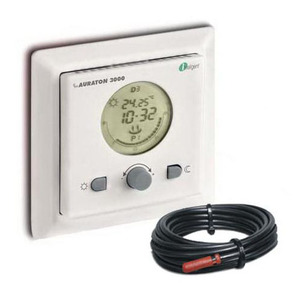 For reliable operation of wired temperature controllers, special attention must be paid to the high-quality installation of conductors.
For reliable operation of wired temperature controllers, special attention must be paid to the high-quality installation of conductors.
This must be done to ensure their uninterrupted connection with the boiler. The signal received by the thermostat leads to the start of the process of supplying the coolant to the heating circuit.
According to their design, thermostats are divided into the following types: wireless and wired.
In wireless devices, the regulation of the work process is carried out through the use of a radio signal which goes to the temperature sensor.
Usually, there are two blocks in the composition of the thermostat for heating boilers. The installation of one of them is carried out in the immediate vicinity of the boiler, it is connected by its terminals.
The installation of another is carried out in a heated room. These two blocks communicate with each other via a dedicated radio channel. The main difference between the main unit and the executive unit is the presence LCD display and keyboard.
Automation Classification
According to such a criterion as the level of automation, thermostats are divided into the following groups:
- Analog.
- Digital.
The characteristic features of analog devices are that they are controlled manually, for which mechanical regulator, which is directly connected to the rheostat.
Through chip signals managed digital device. The use of this type of equipment allows you to use the heating system during operation a large number of temperature regimes.
Classification by sensor type
Depending on the sensor installed in the thermostat, the models of these devices are divided into those with mechanical and electronic sensors.
Devices that have mechanical sensors in their equipment are represented on the market capillary thermostats. They consider the temperature according to the change in the total volume of the heated liquid in the sealed flask. Such a sensor is immersed in a heat exchanger located in a heating device.
The main positive feature is accuracy and durability. As for the shortcomings, the main one can be considered incompatibility with programmable controllers.
If an electronic sensor is installed in the thermostat, then when the controller is operating, it will read signals from the thermistor. The thermistor itself measures resistance under the influence of temperature.
Device advantages
It should be noted that if a programmable thermostat is installed in the heating system of a private house, designed for a gas-fired boiler, then it has the following advantages over simple-type appliances:
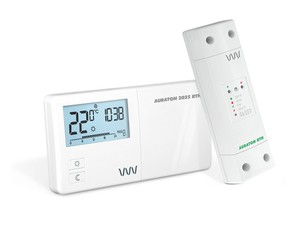
When choosing any device for a boiler, first of all, it is necessary to build on the requirements that apply to its functionality.
If the serious functionality of the device is not important to you, then you can install a simple device in the heating system. In most cases, owners buy programmable thermostat because of its good functionality.
How the thermostat works
 The principle of operation of the device from various manufacturers does not have any significant differences. They may even look the same. The difference is only in minor details. In terms of functionality, they practically do not differ from each other.
The principle of operation of the device from various manufacturers does not have any significant differences. They may even look the same. The difference is only in minor details. In terms of functionality, they practically do not differ from each other.
During operation of the device, coolant heating control and ambient air, for which a sensor is used, which can be built-in or external. The controller sends a signal to turn off and on to the automatic unit installed on the heating boiler.
The shutdown signal is given if the temperature of the heat carrier or ambient air rises above the set value. When it falls below a given level, then signal to turn on heating equipment.
Features of installation work
If the owner decided to install a thermostat in the heating system, then this work can be done by hand. It is advisable to install the device in the coldest part of the house or where people living in the house are most often.
Typically, this device is installed in a place that is convenient for use and which provides free access to it.
Before installing the thermostat for the boiler, you should choose a place to which it is provided constant air supply. This is necessary to ensure its correct operation.
The temperature controller is an indispensable thing for an individual heating system. It not only saves gas, but also makes your life more comfortable. A very pleasant combination of qualities, isn't it? I hope my story will convince you to start using it.
Why you need a room thermostat
It would seem, why complicate the scheme and cling additional device? After all, any heating boiler has its own temperature controller. In simple models, this is a mechanical twist with the numbers 1, 2, 3 ... In boilers, more modern automation is more expensive, which allows you to set the temperature with an accuracy of one degree. However, in both cases, we are talking about the temperature (of water in the heating system), and not of air. Why is it bad?
As an example, let's take my "three-ruble note" in an ordinary Khrushchev, where two windows face north and two - south. What happens on a clear day? Even in winter, the sun noticeably warms up the southern rooms, and it gets a little hot near the window. In a natural way, the heat spreads to most of the apartment and the need for the included heating disappears for several hours.
All this time, the gas boiler, located on the north side, continues to work. After all, heat does not reach there, and the water in the circuit cools quite quickly, giving the boiler a command to turn on. Since there is not much water in the heating system, it quickly heats it up and turns off again.
Thus, the operation of the boiler without room thermostat It looked like this for me: turned on, worked for 2-3 minutes, turned off, turned on again after 10-15 minutes. Needless to say, such a regime negatively affects both gas savings and the resource of the boiler itself. So a few years ago I bought
Mechanical thermostat for heating boiler
The simplest device, which is a small box with a built-in sensor and temperature controller. Connecting a room thermostat to the boiler automatically changes its mode of operation. Now it does not depend on the water in the circuit, but on the ambient air, which cools down much more slowly.
By setting the thermostat to a comfortable temperature, you can forget about its existence. The boiler will turn on much less frequently, which saves you gas and, accordingly, money. When leaving home for a long time or leaving for several days, you can set it to 15-18 degrees, which will further reduce consumption.
The simplest model costs from $15 and saves you this amount for an incomplete season. Comparing the consumption "before" and "after", it turned out that the savings amounted to about 15-20%. Before installing the thermostat, at least 200 cubic meters of gas were consumed, after that it became no more than 170.
The device suited everyone, except, perhaps, appearance, which did not fit into his wife's ideas about modern design. So last year it was replaced
Programmable thermostat for heating system
Performing the same functions as a mechanical thermostat, the programmer has a number of additional "goodies".
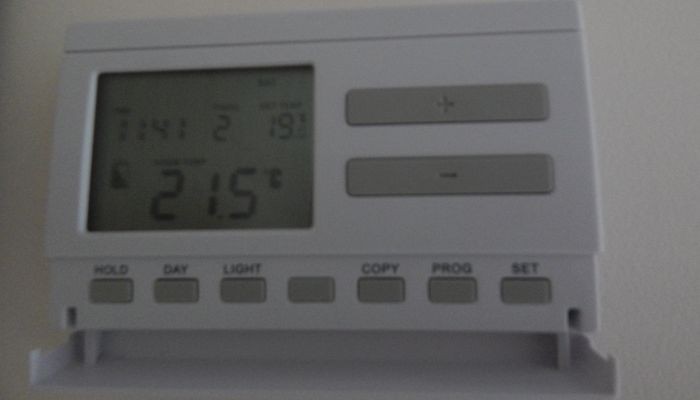
Among the shortcomings can be noted a higher price (from $ 30) and the need for periodic replacement of batteries.
After spending several days studying the capabilities of the device and experimenting, I settled on the following scheme for everyday life:
from 00.00 to 06.00 - 19°C
from 06.00 to 08.00 - 21°C
from 08.00 to 17.00 - 18°C
from 17.00 to 22.00 - 21°C
from 22.00 to 00.00 - 19°C
On weekends, the temperature controller operates in a different mode:
from 00.00 to 07.00 - 19°C
from 07.00 to 22.00 - 21°C
from 22.00 to 00.00 - 19°C
The result made me incredibly happy, and even somewhat surprised. In total, the time of "clean" operation of the boiler was reduced to 2-4 hours a day. It's in the cold. At positive temperatures, heating may not turn on for a day or even more. Despite the fact that all windows are open almost around the clock for micro-ventilation, the temperature in the apartment does not fall below 21°C.
Gas consumption has broken all previous records and now rarely exceeds 150 cubic meters. In fairness, I note that this is hardly the merit of the thermostat alone. Simultaneously with its installation, insulation work and replacement of double-glazed windows with energy-saving ones were carried out. Of course, this affected the reduction of heat loss.
What I can say for sure is that the programmer in combination with insulation gives stunning results. Using a thermostat for a heating boiler, you can achieve maximum efficiency of the entire system and save a lot of money.
Effective control plays an important role in the heating unit. With proper implementation of the control parts in the boiler, it is possible to achieve energy savings, arrangement comfortable microclimate, get rid of overheating or cooling the room. One of these automatic parts is the thermostat.
An automatic device that maintains a given temperature is called a thermostat. A sensor may be built into its design or it may be located outside it. The sensor captures information and transmits it to the zone of the device itself, from where the command is transmitted to the information zone of the boiler, and the unit starts or stops.
There are devices with mechanical and software control.
Purpose:
- Automate combustion processes and make heat transfer to the heating circuit.
- Heating medium temperature control, premises.
- Prevent crashes heat increase.
Principle of operation
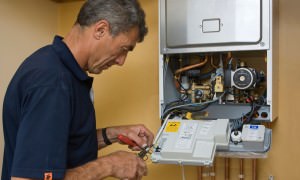
The principle of operation of the solid fuel boiler thermostat
The temperature of the coolant is set on the boiler, when the temperature of the liquid drops, a certain signal is issued and the unit turns on.
Using a thermostat makes it possible to control the room temperature. A sensor is built into it, which is located away from the heating facility, and the device reacts to the environment. The information received from the sensor is transmitted to the control of the unit, on the basis of which it turns on or off.
At the first stage of the invention of thermostats, the connection of two devices was carried out using wires. What can not be said about modern models, now the work is carried out remotely. Thermal devices control and regulate the consumption of energy resources, the temperature of the building, and prevent overheating or hypothermia.
Advantages and disadvantages
Pros:
- Increase the thermal comfort in the room.
- Saving electricity consumption.
- Warning of an emergency situation in the heating circuit.
- Ease of connection.
- Ease of maintenance.
- Wide range of models.
- Fuel economy.
Minuses:
- High price.
Kinds
Central
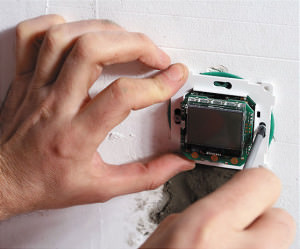
In this form, the temperature of the entire system is controlled. Its installation is carried out in coordination with the boiler. Special wires or other options for wireless transmission of information are used. The element is powered from the mains, although there is some autonomy from the equipment. This type controls the heating of the boiler and the coolant. The devices are not used to adjust individual rooms of one system, but perfectly keep the entire heating system safe.
local value
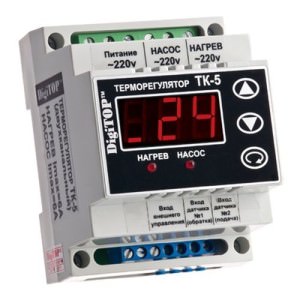
Unlike the previous view, this type can adjust the temperatures in individual rooms. The device is installed in coordination with the boiler. There are some requirements for their location: it is impossible to mount near doors, boilers and windows, as this will distort the temperature data.
The presence of sensors makes it possible to monitor the expansion of the coolant, and thanks to this, the temperature is regulated. Devices of this option can communicate with the boiler for the second time, and if there is an emergency temperature of the circuit, the operation will be suspended and the boiler will turn off.
for radiator
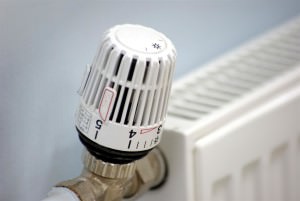
The thermostat controls the temperature of all radiators separate from each other. The radiator includes a valve for reducing and increasing the flow of liquid or gas inside, as well as a thermostat that regulates this procedure. For the device to work correctly, hydraulic calculation for a specific heating system (forced or natural circulation, single or double circuit).
room
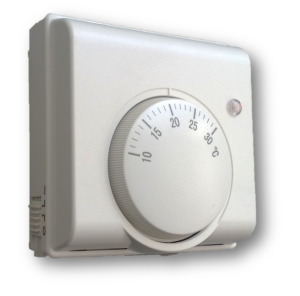
It has the ability to program a specific mode. For example, you can set the heating of the coolant for the night, for the day, a cooler temperature. Its design includes sensors, and they must be placed in different places in the room. They should not be influenced by external factors.
Models without programming have a simple operation scheme. The device has a small wheel that sets the desired temperature in the building. As soon as its threshold is reached, the contacts will close in the device, and a signal will be transmitted to the control part. Any command to open or close a particular valve will be executed in the servo drive.
The types of functions can be distinguished:
- Single operation devices when only the temperature is maintained.
- Multi-operation, where various functions are programmatically enabled.
By design, to match the boiler:
- Wireless.
- With wires.
Devices are installed in any convenient place, the temperature sensor is connected and connected to the control area of the unit. The location of the room appliance must not be covered by, for example, curtains, furniture.
He wants contact with a constant flow of air, this will provide normal work devices. Another detail - the location of electrical appliances (TVs, lamps, etc.) nearby is also undesirable.
Criterias of choice:
- Production of a thermostat and a boiler by one manufacturer.
- Manufacturer.
- Characteristics.
- Options.
Installation / connection and configuration
When mounting a wired device for temperature control, we select a non-sunny area of the room. We will fasten at a distance of 150 cm from the floor. There are terminals on the sensor with the letters COM and NO, we connect a thin two-wire wire here, it must be connected to special terminals (for the thermostat) of the boiler.
The power supply will be finger batteries in the amount of two pieces.
In the wireless type, we will not pull the wires. We connect the executive part to the boiler, and we place the sensors at different points. The signal from the sensor is not afraid concrete floors and other obstacles.
The device also runs on AA batteries.
You can install them not in one copy on different pumps, but several, you just need to set up the signals so that everyone understands their command. The instrument is set up according to the attached instructions, since each type has an individual adjustment.
Price
The cost of production depends on the method of execution, manufacturer, brand, characteristics.
For example, a thermostat-programmer from Ariston costs 4,000 rubles. Outdoor temperature sensor, Italian production - 1000 rubles.
How to do it yourself?
The thermostats that are provided on store shelves have a reliable design, but people who are versed in electrical engineering are trying to make the device on their own.
To do this, stock up on constituent parts, such as, digital display, microcontroller and other elements, and start assembling the simplest circuit at the first stage. Only having received a positive result, you can complicate the task.
Temperature control algorithm
We invite you to get acquainted with the circuit diagram of the device, which reflects the algorithm of the device. Here we see that an element is required to measure the temperature and transmit the signal to the post-processing node. The last element amplifies it and transmits the command to the relay, which serves as an actuator.
Let's consider the simplest scheme.
In order for the current to pass only in one direction, we use a zener diode, since it additionally has control contacts, in comparison with a simple diode.
We apply voltage to the element and in the open state, it will pass current. As soon as its value decreases to the lower limit, the chain will break. The logical control of the circuit here is carried out by a zener diode.
Circuit with a zener diode:
Circuit with a zener diode
We present it in two parts. On the left side of the diagram we show the part preceding the control contact of the relay (K1). The thermal resistor (R4) is the measuring element. If in environment As the temperature rises, its resistance decreases.
The temperature can be adjusted manually, for this we install a variable resistor R1 in the circuit.
The circuit is powered by a voltage of 12 V. In a closed circuit, with the relay on, the control contacts of the zener diode will have a voltage of 2.5 V.
As a power supply, you can use any inexpensive device.
It is better to take a reed relay, for example, RES47 or RES55A. The thermal resistor can be models MMT, KMT or similar.
The principle of operation of the circuit is as follows: the temperature is set to a certain limit, and when it rises above the threshold, on element R4, there will be a drop in resistance and voltage (less than 2.5 V) and the circuit will break.
The power section will be switched off synchronously by the resistance on the right side of the circuit. The thermal relay, equipped with D2, plays the role of an executive unit and the voltage on it is 220 V.



